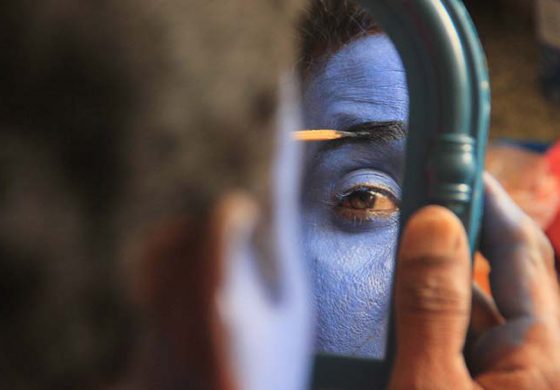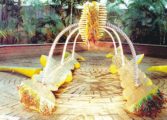Adhyatma as reflection on experience
There is a sense in which adhyatma is almost entirely an activity; whatever speculative or descriptive sense we might be tempted to see in it through the metaphysical lens of onto-theology is entirely subordinate to facilitating the particular kind of activity it engages itself in. What kind of activity is it? In one formulation, we could say that it is an activity that aims to fully realize experience. When talking about reflection on experience, it is important to realize that we invariably use experience to refer to what occurs or happens (bhava), as well as to the result of the activity of assimilating or understanding what happens, what we undergo (anu-bhava). How to turn the happenings – sad or happy, ordinary or extraordinary, natural or social – into experience constitutes the adhyatmic inquiry. Clearly there are any number of ways of saliencing what is important and how to transform that into experience. Elsewhere, I have coined the term “practitional matrix” to conceptualize experiential inquiry that characterizes the Indian intellectual traditions. The thought behind it is something like this: action is always action in a matrix, like a gesture in a dance, sound in a raga, or offering in a ritual. You learn to appease the ancestors and that involves engaging the past in a practitional matrix; you express your gratitude to the implements that have helped in your interaction with the world, so ayudha puja is a practitional matrix that engages the implements. Since there are no events or occurrences that are by themselves trivial or significant and there may be multiple ways of engaging each event or aspect or dimension of what occurs, diversity of practitions is a given. That is why too the diversity of Indian traditions. The central inquiry though is about awareness or self-consciousness – realizing the atman is the way one tradition speaks of it (Vedantins), another might speak of “standing in awareness” (arivinalli niluvu, a phrase used by Vacanakaras writing in Kannada), but none speak of it as a “religious” or “mystical” event only manifest to some, and actually attained by none, as is the case with monasticization in Christianity. The theological or normative frame has, unfortunately, turned the talk of atman into some sort of revelation, and the Bhakti traditions (so-called popular Hinduism) have been accorded the mystic status.
Every element that is potentially a way of completing experience is also a way in which experience could get distorted or occluded altogether. An architect concerned with understanding how space can enhance living, or relationship of those who inhabit it, begins to be parasitic on the real estate sector’s exploitation of land for selling phantasmatic ideas of living. A singer begins to make her musical pursuit secondary to the fame concerts bring in. A politician begins to love his own exploits for the rewards and fame it brings. A scientist becomes enamored of the junketing that international collaborations bring in. These are not unusual examples by any means since any of us could be, or are, in that position. What it highlights is the peculiar structure of parasitism. Doing things for fame or making it motivate your pursuit has ways of occluding and perhaps terminating the really important thing, namely the pursuit itself, because the phantasy supporting the desire conceals the parasitic structure. This is the case even if you are a human being not pursuing anything like science or music. The texture of the relationships could come under strain as one gets caught in a phantasmatic conception of oneself, say, as attractive or tough and so on. What the parasitism ultimately occludes is experience that enables you to have self-knowledge. When Gandhi began to see that colonialism had begun to create parasitism through, for example, medicine, law, and the state, and that these institutions were distorting or occluding experience, he was not distinguishing, as Marxists and Liberals were to do later, colonialism as some material process with no effect on experience (taken in a narrow sense as subjective). The violence of colonialism, he realized, consisted in very deeply fragmenting the saliences that had organized the practitional matrix, thereby in the long run undermining the very integrity of experience. His attempt to reorganize the saliences drew from the same resources that had indeed enabled him to see how the violence of colonialism had a disintegrating effect on experience itself.[3] Stripped of the practitional structure, actions tended to be automatism, occurrences and incidents traumatic. The result was perhaps the last great concept to come out of Indian traditions, namely, satyagraha, yet another concept that resists translation. Could the structure and activities that have become parasitic be transformed through satyagraha into sites of learning? How can new sites of learning be brought into being so that the automatism of actions and trauma of occurrences be transformed into experience, and the phantasy that conceals the parasitic nature and perpetuates desire be therapeutically engaged, if not removed? The crucial concept here is that of sites of learning. There is no limit to the kind of practical learnings there can be which enables one to transform structures, occurrences and emotions into experiences. The body, time, relationships, place…all these can turn into upadhis or they could be transformed into sites of learning. And what is a site of leaning for one tradition may not be for another, or not in the same way. Erotics is a way of learning for one tradition (think of Tantric traditions), for another it is austerity of a certain kind.[4]
The concept “practitional matrix” enables us to understand the way experiential knowledge works and why it is necessarily an ever-expanding field. It helps us model how a rich tradition of kavyas and shastras emerge in the process of tackling multiple aspects of living, whether it is engaging the past, arranging the living space, appreciating beauty, incorporating considerations of taste and health, elaborating erotics, and so on. The cultural learning that this process creates does not consist in any doctrine it yields (the shastras are not doctrines) but structures ways of doing things – practical knowledge, in short. What the process also produces is what we might term action-theoretic concepts, that is, concepts that one understands only by understanding their function in the matrix.[5] Concepts such as manana, shravana, nidhidyasana, or upadhi, avidya, maya too are action-theoretic concepts; they are not (metaphysical or ontological) descriptions of the world. Looking for translations of them as though they are descriptions (even if metaphysical) of the world, has the effect of turning them into obscure, mystic, religious entities. Entities in the world do not come with upadhi written over them, for instance. Whether my body or my past becomes an upadhi depends on my relationship to it. Nor is any entity, action or discipline parasitic in itself. When, for example, I become parasitic on fame, how am I supposed to understand “fame”? What kind of upadhi is it? What makes it one? If, however, we want to understand how upadhi functioned in advaita, we do better by trying to understand parasitism in our contemporary experience. Are we thereby translating upadhi? Or are we drawing on Indian thought to understand ourselves critically? Does recognizing the self-concealment of parasitic structures and activities help us understand why maya was such a powerful insight?
There is thus a disjuncture between the practice of the discipline of philosophy and the cultural learning that underlies Indian thought and its diverse paths of organizing learning and reflection on experience. This raises a large and difficult question about whether this claim implies that western philosophy is inimical to experience or, less strongly, at least to certain ways of reflecting on it. Although the context of Indian thought regimented by philosophy has forced this way of formulating the question, it does nevertheless throw light on why there has been a significant strand of thinking within western philosophy – from Marx and Nietzsche to Heidegger and Wittgenstein – which has sought the end of philosophy. It may well be that the destruction of the past goes hand in hand with the destruction of experience, if indeed it is not the same process. The unease generated by this process must have registered at some level and in some form in Western thinking.[6] Indeed, both philosophy and history come to be regarded with profound distrust by many thinkers after Marx, the most prominent of them being Nietzsche, Heidegger, and Foucault (Wittgenstein too, but he questioned only philosophy). It may be that our attempt – following Gandhi – to bring to bear the cultural learning on the practice of philosophy provides a different, experiential route to the task of clarifying where such a distrust springs from. The practitional matrix is not some fragment of history that is irretrievably lost. It designates the diverse ways in which adhyatmic activity completes experience: relationship to the past is achieved by transmitting the cultural learnings through itihasa, which is itself a variety of practitional matrix.
Indeed, by making the past external to us, history denies such learning. It is historicized away as nostalgia. We glibly say that the past cannot be retrieved, without realizing that we are disowning learning in our confused attempt to be historical. We regard figures such as Ramaksrishna Paramahamsa or Ramana Maharshi as mystics and even if we feel certain awe toward them we conceal that with an expression of condescension. Gandhi gets treated as a benign father of the nation, his thought and action finding no resonance in our thinking. Both history and philosophy, the new tools we proudly use, render them alien to us. We discuss concepts such as atman and upadhi in the same way as we write commentaries on Hegel’s essence and appearance. Without knowing how to understand the two traditions, we treat both traditions as charlatans. If history renders the past external and phantasmatic, philosophy insulates experience from reflection.
We are at home in thinking when our cultural learning is made available for articulation, either as practitions or as theories. When, however, the disciplines of the human sciences actually make us disavow our cultural learning, and do so, moreover, without offering any new learning, we have no choice but to begin the slow work of re-understanding education as setting up of sites of learning, to recover, create, nurture and articulate our cultural learnings. The issue of what that task involves formed the substance of the dialogue between Gandhi and Tagore[7]. It is instructive to rehearse that debate in the light of the framework I have sketched above. In many ways, they had sought to answer the question about how an action becomes part of a practition, how a genuine learning attitude emerges.





